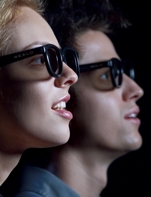Few in Hollywood were surprised this week when it was announced that Avatar will be competing for nine Academy Awards including Best Picture at the Oscars in March.
James Cameron’s science epic film has been touted as a technological marvel with its use of 3D viewing and stereoscopic filmmaking captured with specially-designed cameras.
What’s perhaps even more of a marvel is the film’s ability get people back in the cinemas. For a family of four, a night out a the cinema in London can cost anything above £30 and that’s excluding the popcorn, cokes and sweets. So it’s no wonder more of us credit crunch victims are opting for much cheaper home entertainment whether it be DVDs or the increasingly-popular illegal Internet downloads.
Before Avatar the future of cinema seemed bleak. Now filmmakers have realised the way to get people queuing for premiers again is providing experiences that cannot be recreated in the living room.
Cameron’s 3D viewing and stereoscopic filmmaking techniques will probably have more lasting influence than previous sensory tricks. It’s unlikely any cinema today would again advertise Smell-O-Vision, a technique that wafted odours into auditoriums so viewers could smell what’s happening on screen, or ‘The Tingler,’ a 1959 horror movie that required film-goers to sit in specially-wired seats so they could be subjected to a mild electric shock at the most pivotal blood-curdling moment.

A colleague of mine suggested the future of cinema could be no experience at all. In a sort of Total Recall-like world we’d queue up at the “cinema” only to be given an injection that would implant false memories of a virtual experience of watching a film in our brains. I’d probably much prefer that then sitting through two hours and forty-seven minutes of The Curious Case of Benjamin Button again.
No matter what new filmmaking technology is deployed in the future, it’s good to see cinemas aren’t dying out. For many their first trip to the cinema is a fond memory and it’d be a shame for children in the future not to experience it.
Incidentally the same colleague that suggested the ‘film experience implant,’ took his three year old daughter on her first cinema trip last weekend to see Toy Story 2 in 3D. As it was her first experience, my colleague said she probably believes all films she sees at the cinema in the future will be in 3D. She may be right.





Red Bull makes hydrogen fuel cell play with AVL
Surely EVs are the best solution for motor sports and for weight / performance dispense with the battery altogether by introducing paired conductors...